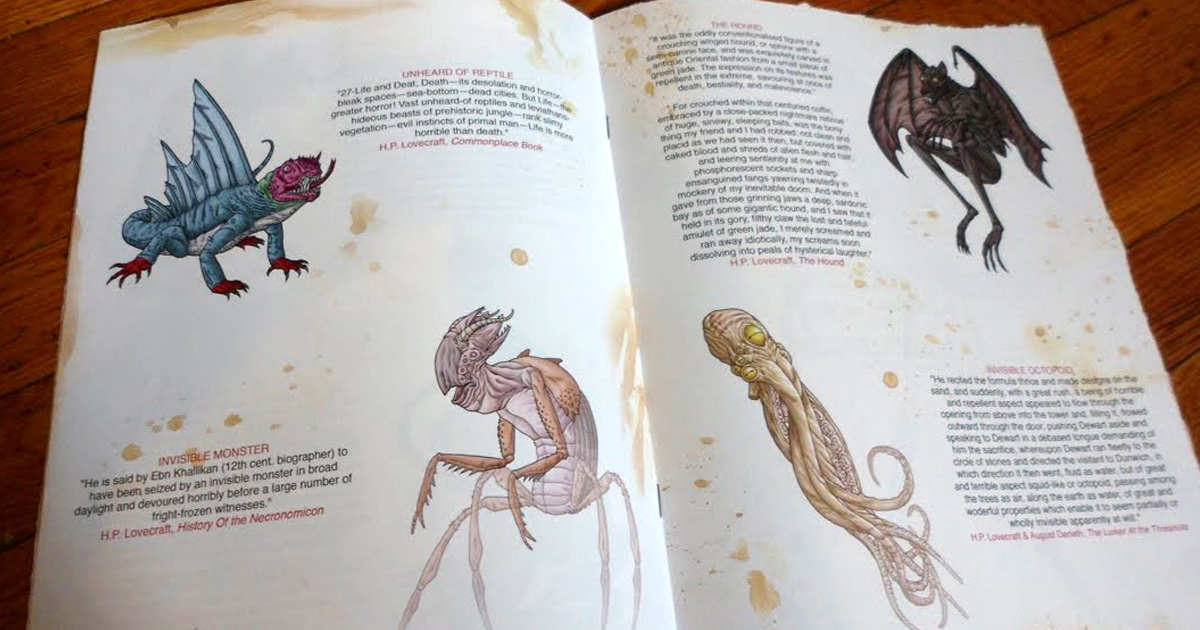This article originally appeared in Issue 3 of The Campaigner. The issue is still available as a digital download.
The Cthulhu mythos is a popular source of inspiration for hobbyists and game developers alike. H.P. Lovecraft’s writing is prolific, and throughout it are spread numerous monsters, gods and horrors. This issue we talk to Mike Bukowski, a crazed mind who is slowly bringing each Lovecraftian creature to life through his work on Yog-blogsoth.
Can you give a brief explanation on what Yog-blogsoth is?
Yog-Blogsoth is a complete (although in progress) Lovecraftian bestiary. That’s it in a nutshell, although there are some guidelines I follow for myself.
What do you find interesting about the Cthulhu mythos? Especially interesting enough to keep a blog regularly updated?
As an atheist, I’m drawn to the bleakness and despair of the whole idea. No, the god you think you know doesn’t exist and these creatures that may be gods are actually just aliens so advanced that they seem supernatural….and oh yeah they could care less if you live or die. (Laughs) So good!
Are images about, or inspired by, Lovecraftian horror the only artwork you do?
No, I’ve actually been a freelance illustrator for about 12 years now (you can see the rest of my work at Last Chance Illustration). I mostly work for punk/hardcore/metal bands and labels. A lot of that stuff has some mythos influence but is more vaguely occult or horror themed. I’ve loved the mythos since I first read H.P. Lovecraft in high school, so it’s hard to avoid even in my professional work.

Is there a process behind which creatures you choose to illustrate?
So, this idea started when I was rereading The Horror In the Museum, and did an image search for people’s representations of Rhan Tegoth. I couldn’t find any (even now there are only a few). As I went through that collection, I kept doing image searches for various monsters and was coming up short. So, I decided to do it myself. Seeing as how illustrating ALL the creatures in the mythos is a daunting task, I set up some guidelines for myself. For instance, I’ll ONLY draw monsters Lovecraft has mentioned himself (or in his collaborations…even, somewhat dubiously, his posthumous collaborations).
So that means all his creations (Mi-go, Yog-Sothoth, Cthulhu, etc) as well as things he may not have created but name drops (Tsathoggua, Hastur, Hounds Of Tindalos, etc). Within the last year I’ve expanded it a bit more to include gods that he mentions that have their roots in actual world religions. I refer to these as ‘Old World Gods’ on the blog. For instance, in Under the Pyramids, he spouts off tons of Egyptian gods. In The Electric Executioner there’s a similar list of Aztec gods and in The Horror At Red Hook he cites a handful of biblical demons. I found it extremely interesting to look these deities up and find out the mythology behind them, and perhaps why Lovecraft chose to include them in his stories. Almost all of them have monstrous attributes! So, it’s become kind of a journey for me, researching these creatures.
Like, when I had to illustrate Chaugnar Faugn, (Lovecraft mentions it in The Horror In the Museum) I had to hunt down a copy of The Horror From the Hills, so I could get an accurate description, and not just a second hand account from a gaming manual. I want actual quotable references for all my work. When I drew Anubis, I wanted to know why he’s portrayed with a black head, or what exactly Quetzalcoatl looks like. I had to cull together a decent amount of citations for Lilith and the Magna Mater. (Laughing) This may sound super serious but I swear all this research is fun!
You have published two volumes of work from Yog-blogsoth. Can you explain the process you went through to create these books? Why do they look they way they do and why are they made the way they are?
There’s a lot that goes into them. First off I wanted them to look like a folio you would find if you were rummaging around Eibon’s lair, or shuffling through the very back of the rare books room at Miskatonic. So, they are made to look like grimoire’s themselves. As far as the process…whew! That’s gonna be pretty long answer. I designed the cover image myself and change the volume number each time. Then I buy appropriate paper, cut it down so it’s about an inch larger than it actually needs to be and draw guides on it. Then I drop it off to my screen printers (Awesome Dudes Printing), pick it up a week later and then trim the edges down by tearing them.
For the interiors, I have to get a bunch of scrap paper, splatter lemon juice on it, wait for it to dry, then hold it over the stove to get the texture for the background. Then I go through and choose (mostly randomly) which creatures I want in the next volume. It has to be a mixture of really obscure weirdos and some better known creatures from some better known stories. After it’s all laid out, I send it off to my printers (Fireball Printing) and they print on paper that’s slightly larger than what I need so I can, again, tear the edges to get the old book feel.
After that I line everything up, staple it, and put faux binding on the spine with gaffers tape. It takes a long time, but I’m super happy with the outcome.
Article continues in Issue 03. The issue is still available as a digital download.




